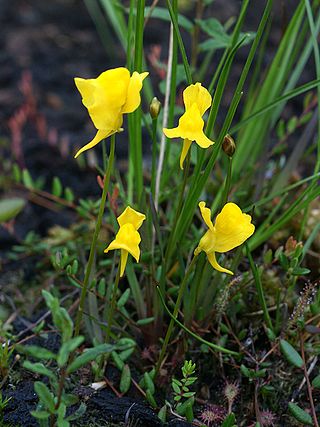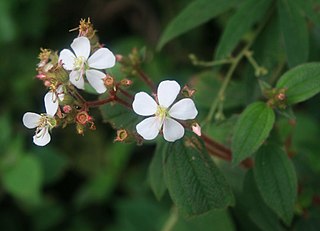
Tibouchina is a neotropical flowering plant genus in the family Melastomataceae. Species of this genus are subshrubs, shrubs or small trees and typically have purple flowers. They are native to Mexico, the Caribbean, and South America where they are found as far south as northern Argentina. Members of this genus are known as glory bushes, glory trees or princess flowers. The name Tibouchina is adapted from a Guianan indigenous name for a member of this genus. A systematic study in 2013 showed that as then circumscribed the genus was paraphyletic, and in 2019 the genus was split into a more narrowly circumscribed Tibouchina, two re-established genera Pleroma and Chaetogastra, and a new genus, Andesanthus.

The horned screamer is a member of a small family of birds, the Anhimidae, which occurs in wetlands of tropical South America. There are three screamer species, the other two being the southern screamer and the northern screamer in the genus Chauna. They are related to the ducks, geese and swans, which are in the family Anatidae, but have bills looking more like those of game birds.

Corylus cornuta, the beaked hazelnut, is a deciduous shrubby hazel with two subspecies found throughout most of North America.

The Surinam horned frog, also known as Amazonian horned frog, is a bulky frog measuring up to 20 centimetres (7.9 in) found in the northern part of South America. It has an exceptionally wide mouth, and has horn-like projections above its eyes. Females lay up to 1,000 eggs at a time, and wrap them around aquatic plants. The frog eats other frogs, fish, lizards, and mice. Tadpoles of the Surinam horned frog attack each other soon after being hatched. This species was once considered the same species as Ceratophrys ornata. This dispute was later settled because the Surinam Horned frog inhabits a different habitat than its smaller cousin and does not interbreed with it in the wild. This species has been known to prey upon the other species of horned frog, especially the northern race of Ceratophrys ornata.

The Wych Elm cultivar Ulmus glabra 'Cornuta', in cultivation before 1845 – Fontaine (1968) gives its provenance as France, 1835 – is a little-known tree, finally identified as a cultivar of U. glabra by Boom in Nederlandse Dendrologie 1: 157, 1959.

The rhinoceros iguana is an endangered species of iguana that is endemic to the Caribbean island of Hispaniola and its surrounding islands. A large lizard, they vary in length from 60 to 136 centimetres, and skin colours range from a steely grey to a dark green and even brown. Their name derives from the bony-plated pseudo-horn or outgrowth which resembles the horn of a rhinoceros on the iguana's snout. It is known to coexist with the Ricord's iguana ; the two species are the only taxa of rock iguana to do so.

The horned marsupial frog, originally named Nototrema cornutum (Boulenger) after the first describer George Albert Boulenger in 1898), is a species of frog in the family Hemiphractidae. It is an arboreal species found in Colombia, Costa Rica, Ecuador and Panama. Its natural habitats are tropical moist lowland forests and montane cloud forests. It is threatened by habitat loss.

The horned coot is a species of bird found in the Andes of South America. It was described by Bonaparte in 1853 based on a specimen collected in Bolivia. For a long time it was known only from the type specimen.
Chaetogastra oroensis, synonym Tibouchina oroensis, is a species of plant in the family Melastomataceae. It is endemic to Ecuador.

Utricularia cornuta, the horned bladderwort, is a small to medium-sized, probably perennial species of carnivorous plant in the family Lentibulariaceae. It is endemic to North America and can be found in the Bahamas, Cuba, Canada, and the United States. Utricularia cornuta grows as a terrestrial or subaquatic plant in marshes, swamps, and pools in shallow waters, mostly at lower altitudes. It was originally described and published by André Michaux in 1803.

Nepenthes cornuta is a tropical pitcher plant native to the Philippines. It is known only from the Pantaron Mountain Range of central Mindanao, where it grows terrestrially on ultramafic soils at around 1000 m above sea level.

Cornuta is an extinct order of echinoderms. Along with the mitrates, they form the Stylophora.
The Wych Elm cultivar Ulmus glabra 'Grandidentata', listed as U. glabra var. grandidentata (Moss), may have been the tree first described by Dumortier in Florula Belgica, 25, 1827, as U. corylacea var. grandidentata, in cultivation before 1830. Green thought it a synonym of 'Cornuta'. 'Grandidentata' may be synonymous with U. glabra 'Corylifolia', which Green thought another synonym of 'Cornuta'.

Chaetogastra grossa, synonym Tibouchina grossa, is a species in the Melastomataceae family that is native to Colombia, Ecuador and Venezuela. It is found between 2400 and 3800 meters in elevation. Also called "red princess flower" or "carmine princess flower" to differentiate it from "princess flower" which has purple blooms.

Chaetogastra is a genus of flowering plants belonging to the family Melastomataceae. Its native range is South America and North America. It contains around 115 species.

Chaetogastra herbacea, synonym Tibouchina herbacea, is a species of flowering plant in the family Melastomataceae, native to southern Brazil and north-eastern Argentina. It has been introduced to Hawaii. It was first described, as Arthrostemma herbaceum, by Augustin de Candolle in 1828.

Chaetogastra ciliaris is a species of flowering plant in the family Melastomataceae, native to Colombia, Costa Rica and Ecuador. It was first described as Meriania ciliaris by Étienne Ventenat in 1807. Its synonyms include Tibouchina ciliaris.

Chaetogastra clinopodifolia is a species of flowering plant in the family Melastomataceae, native to south and southeastern Brazil. It was first described by Augustin de Candolle in 1828. One of its synonyms is Tibouchina clinopodifolia.

Chaetogastra rufipilis is a species of flowering plant in the family Melastomataceae, native to Mexico. It was first described by Diederich von Schlechtendal in 1839 as Rhexia rufipilis. One of its synonyms is Tibouchina rufipilis.

Chaetogastra versicolor is a species of flowering plant in the family Melastomataceae, native to Brazil. It was first described by John Lindley in 1827 as Rhexia versicolor. One of its synonyms is Tibouchina versicolor.


















